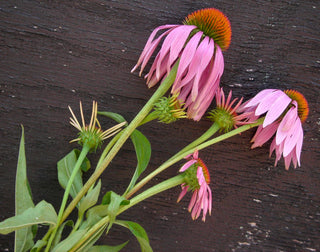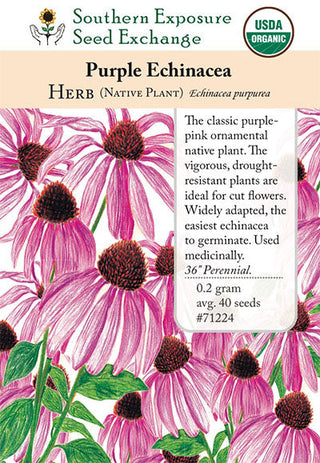71224 - Echinacea Purpurea (Purple Coneflower)
| Pricing Tier | Discount | Guaranteed Sale $/Packet | Outright Buy $/Packet |
|---|---|---|---|
| Tier 1: 150–399 packets | — | $2.30 | $1.73 |
| Tier 2: 400–999 packets | 5% | $2.19 | $1.61 |
| Tier 3: 1000+ packets | 10% | $2.07 | $1.50 |
| Visit our pricing page for more details | |||
Description
A very popular ornamental and the most common Echinacea species, widely used as a medicinal plant. The flowers are 3-4 in. across with pink-orange cone-shaped centers and purple-pink rays. Easy to germinate and widely adapted. Unlike other Echinaceas the seeds do not require cold treatment, the roots are fibrous rather than taprooted, and the plant is more highly branched at the top.
Growing instructions: Perennial in zones 3-9. Transplant or direct seed. Full sun. 24-36 in. tall. All Echinaceas are drought resistant. Keep young plants well weeded. Germination is typically around 50%. 7 days of stratification at 40°F will enhance germination.
Medicinal: All 9 species are medicinally important, and all parts of the plant have some activity. Several pharmacological studies have demonstrated immunostimulant, bacteriostatic, and anti-viral activity. It may be used as an anti-microbial anywhere in the body. It activates macrophages, increases white blood cell levels, and inhibits microbial hyaluronidase (an enzyme that causes host cells to break down), but it is contraindicated in autoimmune system disorders and progressive diseases.
Description
A very popular ornamental and the most common Echinacea species, widely used as a medicinal plant. The flowers are 3-4 in. across with pink-orange cone-shaped centers and purple-pink rays. Easy to germinate and widely adapted. Unlike other Echinaceas the seeds do not require cold treatment, the roots are fibrous rather than taprooted, and the plant is more highly branched at the top.
Growing instructions: Perennial in zones 3-9. Transplant or direct seed. Full sun. 24-36 in. tall. All Echinaceas are drought resistant. Keep young plants well weeded. Germination is typically around 50%. 7 days of stratification at 40°F will enhance germination.
Medicinal: All 9 species are medicinally important, and all parts of the plant have some activity. Several pharmacological studies have demonstrated immunostimulant, bacteriostatic, and anti-viral activity. It may be used as an anti-microbial anywhere in the body. It activates macrophages, increases white blood cell levels, and inhibits microbial hyaluronidase (an enzyme that causes host cells to break down), but it is contraindicated in autoimmune system disorders and progressive diseases.


